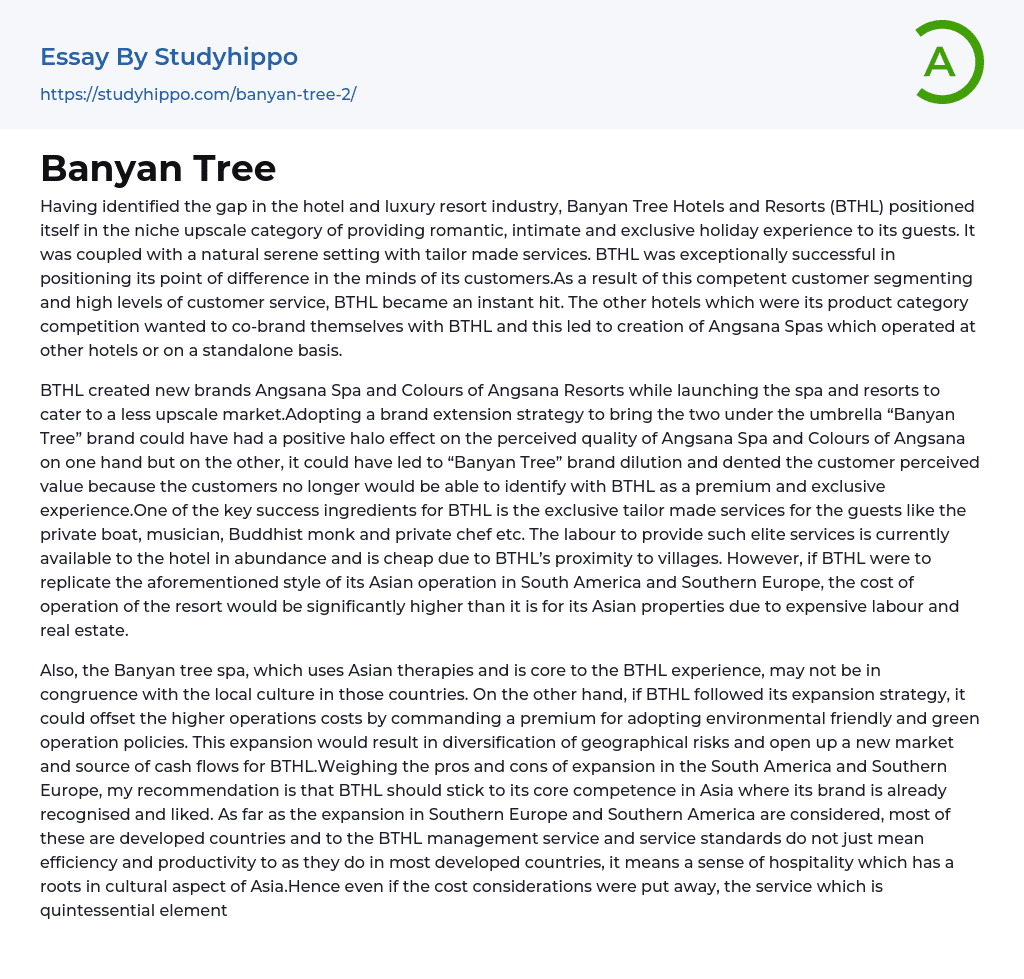Banyan Tree Hotels and Resorts (BTHL) identified a gap in the hotel and luxury resort industry and positioned itself to provide an upscale, exclusive, and romantic holiday experience for guests. BTHL's success was attributed to its natural serene environment and tailor-made services that differentiated it from its competition. Thanks to BTHL's effective customer segmentation and top-notch customer service, it instantly gained popularity. Other hotels in its product category competition even wanted to co-brand themselves with BTHL, which led to the creation of Angsana Spas that operated on a standalone basis or at other hotels.
BTHL launched Angsana Spa and Colours of Angsana Resorts as new brands to target a less exclusive market. While using a brand extension strategy to bring these under the "Banyan Tree" brand could have boosted their perceived quality, it also risked diluting the premium and exclusive e
...xperience associated with BTHL. One of BTHL's key success factors is offering tailored services for guests, such as private boats, musicians, Buddhist monks, and chefs, which are currently cheap due to the hotel's proximity to villages. However, replicating this style of operation in South America and Southern Europe would be significantly costlier due to expensive labour and real estate.
Despite the fact that the Banyan tree spa, which utilizes Asian therapies, is integral to the BTHL experience, it may not align with local customs in other countries. Nonetheless, if BTHL pursued its expansion strategy, it could counterbalance higher operational expenses by charging a premium for incorporating eco-friendly and sustainable operating policies. This expansion would diversify geographical risks and provide a new market and source of revenue for BTHL. Weighing the benefits and drawbacks of expanding into
South America and Southern Europe, my recommendation is for BTHL to remain focused on its core competency in Asia, where its brand is already established and well-liked. Particularly in developed countries such as those in Southern Europe and South America, effective management and service standards go beyond just efficiency and productivity; in Asia, they include a sense of hospitality rooted in cultural aspects. Therefore, even if cost considerations were disregarded, the service that is pivotal to BTHL's success may not match the level found in BTHL outlets in Asia.
Alternatively, they have the option to expand their operations in alternative Asian locations and capitalize on their established brand identity and expertise within the region. In addition, there are several success factors worth considering such as identifying the ideal location, targeting niche markets with high customer-perceived value, having strong leadership and travel experience from the owner, offering low-cost options with high value for money, and creating a blue ocean strategy.
Moreover, the brand's identity should focus on environmental friendliness, preservation of eco-systems, and bio-degradable products while prioritizing customer needs. Brand associations and personality traits should reflect caring, romance and intimacy, social and cultural sensitivity, privacy, and authenticity. The brand's vision is that of a sanctuary for the senses which spans across different locations, and its positioning should focus on unique selling points such as intimate moments, private pools, spas and art galleries, building memories, engaging in CSR activities such as environmental reservation, providing a sense of place for guests to experience something different every time they visit.
... offer the desired audience because they deliver...
Outperforming their rivals.
The text describes various aspects of brand creation and management, including brand
elements like Banyan tree and tagline, brand experience and essence emphasizing the romance of travel. It also includes brand internalization through HR/employee welfare, brand standards, physical evidence, processes, product, price, place, and promotion. In addition, it mentions brand architecture such as brand and product portfolios. The entire text is contained within a single HTML paragraph tag.
- Wal-Mart essays
- Discover essays
- Brand Equity essays
- Branding essays
- Nike, Inc. essays
- Market share essays
- Razor essays
- Advertisement essays
- Advertising essays
- Anheuser-busch essays
- Audience Theory essays
- Brand essays
- Brands essays
- Competitor Analysis essays
- Consumer essays
- Detergent essays
- Marketing Management essays
- Marketing Mix essays
- Marketing Plan essays
- Marketing Research essays
- Marketing Strategy essays
- New Product Development essays
- Point Of Sale essays
- Price essays
- Procurement essays
- Product essays
- Product Differentiation essays
- Product Placement essays
- Promotion essays
- Promotion And Marketing Communications essays
- Research Design essays
- Retailing essays
- Trademark essays
- Board Of Directors essays
- Brand Management essays
- Business Ethics essays
- Business Management essays
- Change Management essays
- Comparative Analysis essays
- Decision Making essays
- Dispute Resolution essays
- Knowledge Management essays
- Leadership essays
- Leadership and Management essays
- Manager essays
- Operations Management essays
- Performance Management essays
- Product Management essays
- Project Management essays
- Quality Management essays




